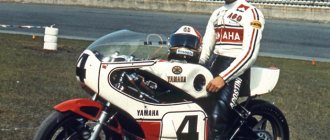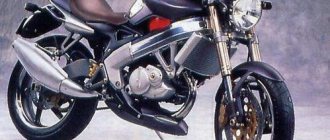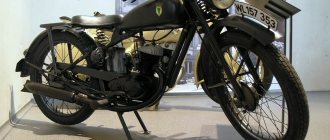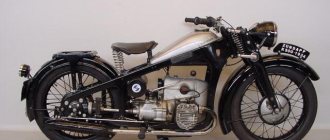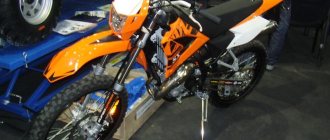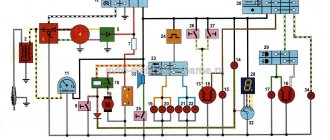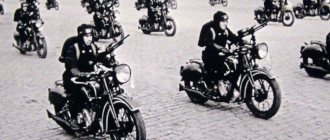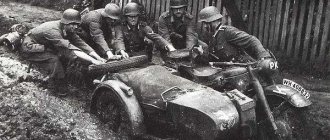This year marks the 135th anniversary of the world's first motorcycle. Its creators were German engineers Daimler and Maybach, who later became the founders of famous automobile brands. The first domestic motorcycle was developed and put into production at , which was succeeded years later by JSC UEC-Klimov.
The L-300 became legendary in its own way - it drove along the roads of the Great Patriotic War, opened motorsports to many, and took part in record-breaking races. “Oktyabryat”, as the L-300 is often called, has little left to our time. One of the cars has been preserved for history and is an exhibit of the UEC-Klimov museum.
From a German bike to a Soviet motorcycle
In the mid-1920s, the Soviet government began to seriously think about the development of the domestic motor industry. Initially, the creation of our own motorcycle models and the organization of their mass production were discussed. But it soon became obvious that the development of original designs was not a quick task, and the country was in dire need of motor vehicles. The following way out of the situation was found - to take a suitable foreign motorcycle as a basis, modify it to suit Russian conditions and put it into production.
When choosing among European models, German ones were considered first. And this is not surprising - Germany, being the birthplace of the world’s first bike, had by that time achieved significant success in motorcycle construction. The first motorcycle with an internal combustion engine was built in 1885 by German engineers Gottlieb Daimler and Wilhelm Maybach - in the future, these names would be associated exclusively with famous cars. Then, at the end of the 19th century, Daimler and Maybach became the authors of the first classic motorcycle with a 1.5 liter gasoline engine. With. and a maximum speed of up to 12 km/h.
The first domestic motorcycle was based on the German DKW Luxus 300, which was considered the most reliable bike in the early 1930s. It was on the basis of this model that Leningrad designers prepared drawings of the first production Soviet motorcycle. However, it is worth noting that experimental models have been created in the country before. Back in 1929, several prototypes were manufactured at the Izhevsk plant (the current Kalashnikov Concern). They were created under the leadership of the talented engineer and designer Pyotr Mozharov, who would later lead the work on the first production motorcycle in Leningrad.
Photo: Military Technical Museum
The model was named “L-300” (Leningradsky, 300 cc engine). The motorcycle weighing 125 kg reached speeds of up to 80 km/h, while the average gasoline consumption was about four liters per 100 km. Since the autumn of 1931, the country mastered the production of all units for the L-300 - from that moment on, production became import-independent.
M-72
This motorcycle was produced at five large automobile factories in Moscow, Leningrad, Gorky, Kyiv and Irbit. In 1941-1960, production of the M-72 was launched in large quantities. However, until 1955, the motorcycle was intended only for use in the armed ranks of the Soviet army. Later it became available to ordinary citizens of the country. In total, about 8,500 copies of the motorcycle were produced. After the end of the Second World War, the motorcycle entered service with the police.
Along military paths into motorsports
The L-300 motorcycle was produced until the end of 1939 - in total, about 19 thousand motorcycles of this model were manufactured. And even when by 1940 their design was already “morally” outdated, and Izhevsk “motor legends” came to replace them, Leningrad L-300s were still in demand due to their high reliability and ease of control. This was proven in practice - the L-300 was actively used in the Red Army as reconnaissance and communications motorcycles. They took part in the battles at Khalkhin Gol and Khasan, in the Soviet-Finnish War and at the beginning of the Great Patriotic War.
The L-300 also took an active part in the development of domestic motorsports - it was widely used in races, cross-country races, record races and long-distance runs of thousands of kilometers. At competitions, the L-300 often won prizes in competition with famous foreign motorcycles.
Photo: Military Technical Museum
And, perhaps most importantly, the L-300 provided thousands of Soviet people with the opportunity to ride a motorcycle for the first time. At the same time, the experience of organizing serial production of the L-300 helped in the production of domestic motorcycles of new generations. This is how the first Soviet sports road motorcycle L-500 appeared, followed by the L-8 with many racing modifications and a speed of about 140 km/h. The legendary Izhevsk motorcycles Izh-7 and Izh-8 also became “descendants” of the L-300. The latter is considered a real Soviet legendary bike, and also gained fame abroad. The Izh-8 motorcycle is even stamped on New Zealand silver coins.
In addition to Izhevsk, serial production of motorcycles was established in Podolsk, Taganrog, and Serpukhov. But still, Leningrad and the L-300 model were the first. Today this motorcycle can no longer be seen on the roads, but can be seen in the museum. One of the copies of this model is exhibited in the museum of JSC "ODK-Klimov".
Vyatka VP-150
The first scooter produced on the territory of the Soviet Union was the Vyatka VP-150. The prototype was taken from the Italian Vespa, produced in 1955. The Vyatsko-Polyansky Machine-Building Plant produced motor scooters from 1957 to 1966. For almost 10 years, more than a million copies of “Vyatka” were sold in the USSR. Subsequently, the scooter received the unofficial title of “the most disco” transport.
A new version
The new Yamaha XJ6 Diversion is a completely different motorcycle. It doesn't have the disadvantages of the first generation. And the price is very, very attractive. The model is perfect for beginner motorcyclists.
In general, the Yamaha XJ6 is a kind of variation of the Yamaha FZ6 (this unit has been sold in Europe instead of the XJ6 since 2009). In the American market, the XJ6 is called the Yamaha FZ6R. The appearance of the Yamaha XJ6 motorcycle in Europe is associated with the desire of the company's management to offer motorcyclists a low-power and budget model that would be aimed at the maximum number of potential buyers. The XJ6 is much cheaper in price, taxes and insurance than the original Yamaha FZ6 (98 horsepower engine).
It is worth noting that many manufacturers try to create very powerful and fast motorcycles, but for some reason they sometimes forget about transport for beginners. But this is more than it seems at first. This is a model for beginners, for girls, and for those who simply love measured motorcycle riding. It is very gratifying that at least someone produces real things for this large category of buyers.
Aprilia RSV 1000R Mille
Produced since 2004, the Aprilia RSV 1000R Mille never ceases to amaze with its beautiful lines and body features. Its strong feature is its chassis and suspension, its suspension does not require any additional adjustments and immediately after purchase, you can go to the track on it. Even at high speed you will never feel uncomfortable and the bike will always cater to the riders' wishes.
His characteristics are not record-breaking, but this is enough for such an extraordinary Italian. The engine displacement is 998.9 cubic centimeters, the maximum power is 180 horsepower, the dry weight is 184 kilograms, the fuel tank volume is 17 liters, and the ground clearance is 130 mm. The cost of this bike from scratch is $13,000, but you can buy such a unit for about 5 thousand dollars.
Harley Davidson Cosmic Starship
The Harley Davidson brand is well-known by a large number of people, and its creations constantly find their way into one or another top list.
Cosmic Starship rightfully takes sixth place on our list due to its “cosmic” price. Partly, this price tag was due to the fact that the famous American artist, Jack Armstrong, worked on tuning the bike. LikeDislike
He applied an intricate design to the surface of the motorcycle, which he secured with 37 layers of clear varnish. In addition to gold paint, Harley received unusual bows on the body. Cosmic Starship does not have any outstanding technical characteristics.
The buyer pays only for the uniqueness and prestige of the model. It would seem that there is nothing special in appearance; moreover, not all ordinary people will like the design of the product. But truly rich collectors are willing to shell out a lot of money for an exclusive.
This motorcycle was placed in the show-room of an official dealer in Los Angeles. The public premiere was attended by media personalities, celebrities and politicians. An inscription was installed near the bike, which prohibited anyone except Lady Gaga and Sylvester Stallone from touching the exhibit.
Japanese motorcycle Suzuki TL 1000
do not buy Suzuki TL 1000 motorcycles
The sporting success of the V2 Ducati Superbos forced the Japanese to act. In 1997 they introduced two V-twins - the successful Honda VTR 1000 liter motorcycle and the troublesome Suzuki TL 1000 S liter motorcycle (which was joined a year later by the same-flawed TL 1000 R).
Biggest Disadvantages
The TL was scary - it had a tendency to vibrate, which even caused fatal accidents. Therefore, a year after the premiere, the company installed steering shock absorbers not only for new, but also for sold motorcycles. Unfortunately, the tendency for the steering wheel to turn over continued; the shock absorber only extinguished it.
Result? On rough roads it is scary to exceed 140 km/h.
The engine also had shortcomings - through leaking pistons/rings, it pumped oil into the air filter - under warranty there was a replacement (depending on the mileage) either on the piston rings themselves or on the pistons.
Another problem was the electronics. The engine could jerk and stall at idle. It was necessary to ensure that the idle speed was set correctly (1300–1400 rpm), after which the ECM was modified.
Oil dilution by fuel is another disadvantage. The thermostat was replaced under warranty. The engine was “too cold” and was trying to take too long to suck. This condition also caused high fuel consumption.
Suzuki spare parts (Suzuki), online order
Cracks in a tank that was not properly secured.
The frame of the eye, which protrudes from the vane damper due to the non-standard shock absorber (such were, for example, on GAZ cars) with which the TL was equipped. The quality of its damping, despite the possibility of adjustment, was not the best.
Cracked frames on the head. At first they argued that this was due to frequent driving, but then it turned out that this was not the case - the frames were breaking.
So you will never know which bike you will get or how many defects have been fixed on it, because all the improvements and repairs were done on a regular basis. Which doesn't change the fact that some of them are indelible.
IZH-49
The IZH-49 was created for driving across the vast expanses of our homeland. In the period from 1951 to 1958, motorcycles were produced at the machine-building plant in the city of Izhevsk. For the transportation of goods there was a modification with a sidecar. The motorcycle was characterized by a high degree of reliability and cross-country ability.
Many Russian families still have Soviet motorcycles inherited from their grandfathers. Do you have a rarity from the USSR era in your garage?
Harley-Davidson Softail Slim
The legendary Harley-Davidson Softail Slim is a motorcycle that has nothing superfluous, but rather only the essentials. Namely: the famous “Hollywood” steering wheel, chrome parts, black wheel rims, massive parts, an air filter with a black round cover. All this is done in the spirit of minimalism, and these are not all the external advantages that help it combine the style elements of the brutal bobbers of the good old 1950s.
The Twin Cam engine itself, with a displacement of 103 cc. inches gives the motorcycle enough power to handle steep climbs with ease and feeling confident on the trail is no problem.
